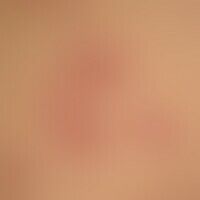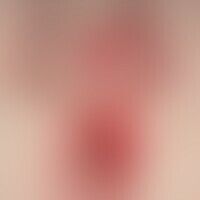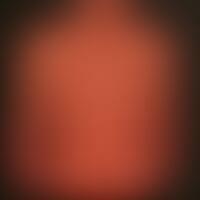Image diagnoses for "Plaque (raised surface > 1cm)", "red"
423 results with 1872 images
Results forPlaque (raised surface > 1cm)red

Lupus erythematosus (overview) L93.-
Lupus erythematosus: cutaneous chronic (scarring) lupus erythematosus (chronic discoid lupus erythematosus). years of progression with circumscribed red scarring plaques (circle - with whitish scarring - atrophic area without follicular structure): arrow: dermal melanocytic nevus.

Acrodermatitis continua suppurativa L40.2
Acrodermatitis continua suppurativa: for years a chronic recurrent clinical picture with painful pustules, nail destruction with formation of erosive areas

Angioimmunoblastic T cell lymphoma C84.4
Angioimmunoblastic T-cell lymphoma: Dress syndrome in AIP. Figure taken from: Mangana Jet al. (2017)

Erythema anulare centrifugum L53.1
Erythema anulare centrifugum: characteristic (fresh) lesions with peripherally progressive plaques, which are peripherally palpable as well limited (like a wet wolfaden) Histological clarification necessary.

Infant haemangioma (overview) D18.01

Deposit dermatoses (overview) L98.9
Plaqueform mucinosis of the skin: follicle-accentuating (peau d'orange) deposits of mucin in the skin.

Kaposi's sarcoma (overview) C46.-
Kaposi sarcoma HIV-associated: flat, symptomless plaques; HIV infection known for several years.

Lupus erythematosus acute-cutaneous L93.1
lupus erythematosus acute-cutaneous: clinical picture known for several years, occurring within 14 days, at the time of admission still with intermittent course. anular pattern. in the current intermittent phase fatigue and exhaustion. ANA 1:160; anti-Ro/SSA antibodies positive. DIF: LE - typical.

Pemphigus chronicus benignus familiaris Q82.8
Pemphigus chronicus benignus familiaris: chronic, extremely therapy-resistant, sharply defined, red, marginalized verrucous plaques.

Psoriasis vulgaris L40.00

Mixed connective tissue disease M35.10
Mixed connective tissue disease. hyperkeratoticnail folds with elongated capillaries and focal haemorrhages. Note the splatter-like scars on the back of the fingers as well as the expression of focal, now healed scarred, cutaneous vascular occlusions.

Intertriginous psoriasis L40.84
Psoriasis intertriginosa: extensive psoriatic affection of the scrotum combined with distinct itching, especially when sweating (DD: atopic scrotal eczema)

Psoriasis palmaris et plantaris (plaque type) L40.3
Psoriasis palmaris et plantaris (plaquet type): chronic stationary keratotic plaques on the soles of the feet and toes, in this case spreading to the backs of toes and feet.

Contact dermatitis allergic L23.0
Contact dermatitis allergic: Multiple (both eyelid regions affected), acute, blurred, low consistency, itchy and burning, red, slightly moist plaques.

Exfoliation areata linguae K14.1
Exfoliatio areata linguae. 2 anular, "plaque free" areas. low burning sensation with spicy food or fruity drinks. characteristic for the clinical picture are the whitish swollen border areas. otherwise normal coating of the tongue

Eyelid dermatitis (overview) H01.11
Chronic contact allergic dermatitis: therapy-resistant, chronic dermatitis caused by beta-blocker-containing eye drops (in case of glaucoma). Only by changing the therapeutic agent a complete healing of the chronic dermatitis could be achieved. In the meantime a 1% hydrocortisone vaseline was applied twice a day.








